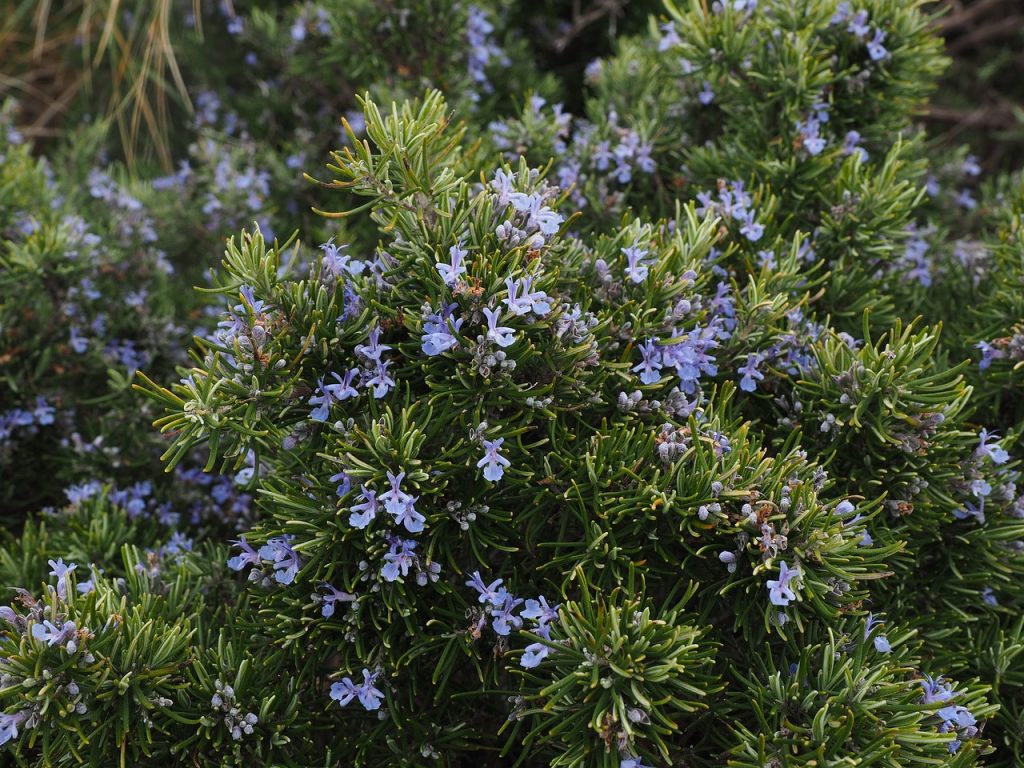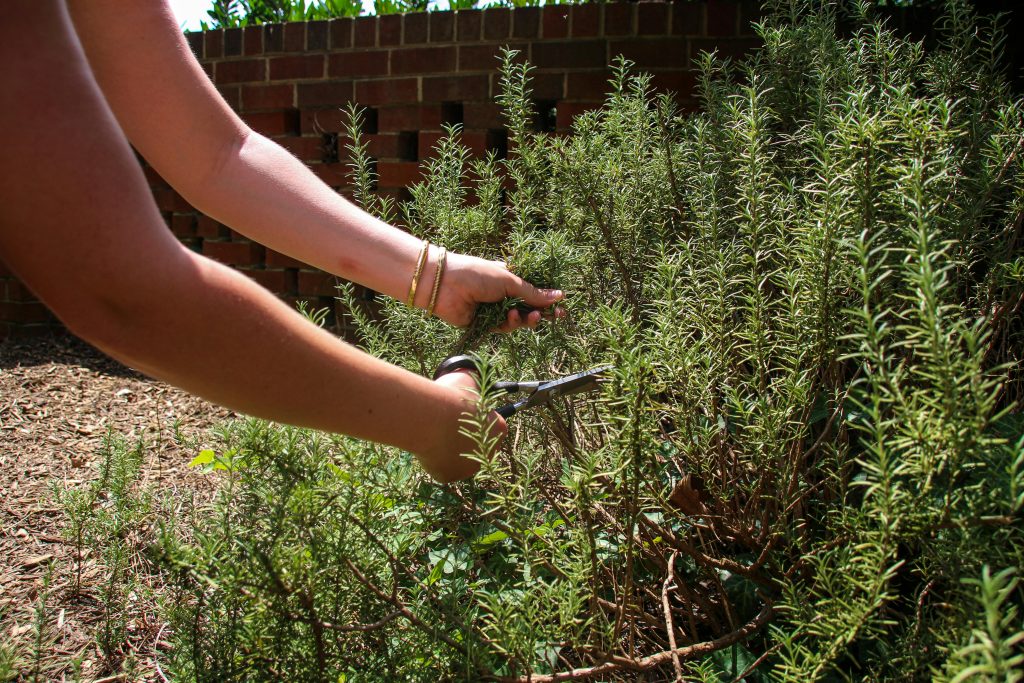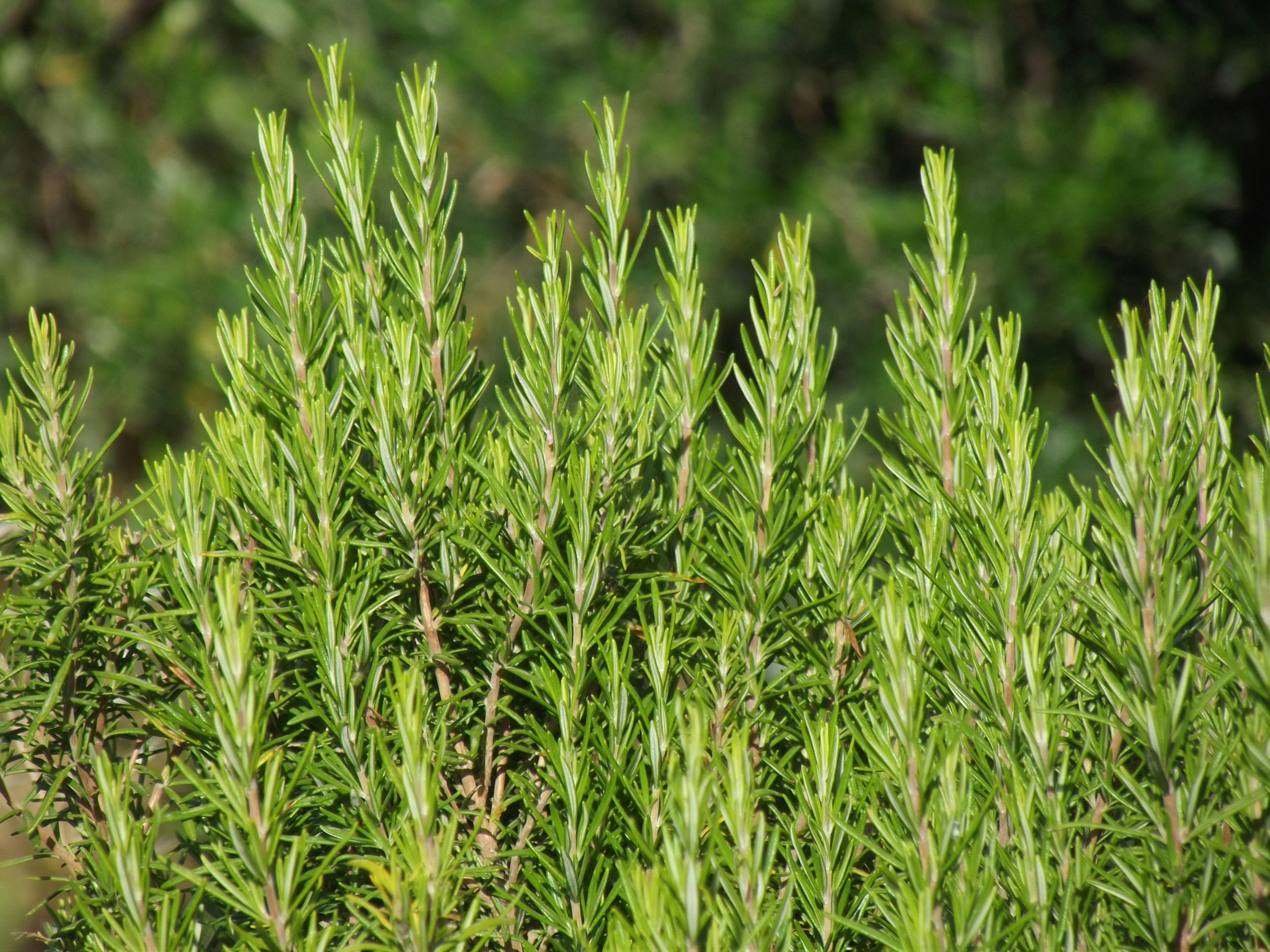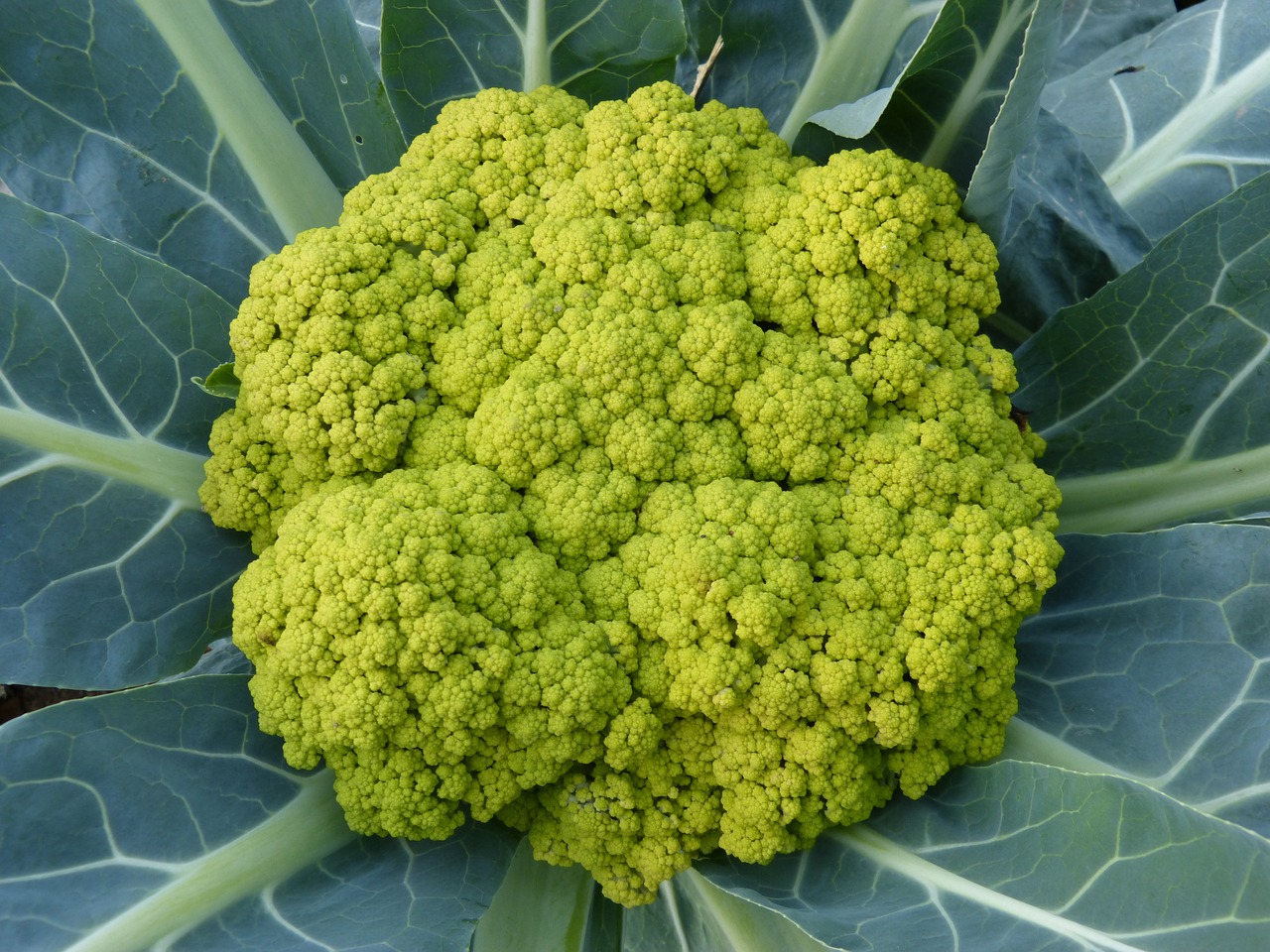One of rosemary’s most enthralling features is its fragrance. The leaves emit a strong, pleasant aroma when crushed, a mix of pine and citrus, which is invigorating and soothing. The evergreen shrub grows dense foliage and dainty flowers which attract pollinators such as bees to a garden.
Rosemary can be shaped into hedges, topiaries, or grown as a standalone shrub. It can be added to sauces, meats, bakeries and oils to impart its distinct flavor and aroma. Its versatility in landscaping design and culinary applications makes it a valuable addition to any garden.

Description
Rosemary (Salvia rosmarinus) is a perennial herb that belongs to the Lamiaceae family, commonly known as the mint family. This family includes a variety of aromatic herbs widely used in culinary and medicinal applications, such as basil, mint, oregano, thyme, and sage.
Rosemary grows as a shrub that produces needle-like leaves that are dark green on the top and silver-gray on the underside. The stems are woody and can become quite thick and sturdy as the plant matures. Rosemary flowers are small, tubular and exist in shades of pale blue, white, pink and purple. The flowers appear in clusters along the stems, typically in the spring and summer, though they can bloom sporadically throughout the year in warmer climates.
Rosemary is rich in antioxidants and anti-inflammatory compounds. It has been traditionally used to improve digestion, boost memory and concentration, and relieve muscle pain.
| Botanical name: Salvia rosmarinus | Propagation: Seeds, cuttings, layering |
| Common name: Rosemary | Soil type: Loamy, sandy loam |
| Family: Lamiaceae | Soil pH: 6.0-7.5 |
| Plant type: Perennial, herb | Temperature: 70-85°F |
| Hardiness zones: USDA zones 7-10 | Light: Full sun |
| Mature size: 1-4 ft. tall, 2-8ft. wide | Spacing: 12 inches |
| Flower color: Pale blue, white, pink, purple | Pollination: Insects, wind |
| Time to maturity: 6 months to 1 year | Toxicity: Nontoxic |
| Native area: Mediterranean |
Temperature requirements
Rosemary prefers to grow at temperatures between 70-85°F (21-29°C). It can withstand occasional light frosts but may suffer damage if exposed to prolonged freezing temperatures below 20°F (-6°C).
Soil requirements
Rosemary prefers soil that drains well to prevent waterlogging, which can lead to root rot. Sandy loam or loamy soil with good drainage is ideal. If your soil is heavy or clay-like, you can improve drainage by adding organic matter like compost or perlite.
Rosemary thrives in slightly acidic to neutral soil with a pH range between 6.0 and 7.5. Test your soil pH and amend it if necessary, using materials like lime to raise pH or sulfur to lower it.
Rosemary doesn’t require rich or highly fertile soil. In fact, overly rich soil can lead to excessive leaf growth at the expense of essential oils and flavor. Avoid adding high-nitrogen fertilizers, which can encourage lush foliage but may compromise the flavor and aroma of the herb.
Light/Sun requirements
Rosemary performs best when grown in full sunlight, receiving at least 6-8 hours of direct sunlight each day. Placing it in a location with ample sunlight ensures robust growth and encourages the plant to produce aromatic foliage.
When to plant Rosemary
In regions with mild winters and warm springs, plant rosemary in early to mid-spring. This allows the plant to establish itself before the heat of summer arrives.
In regions that do not experience frost, rosemary can be planted at any time of the year.
If you’re growing rosemary indoors or in containers, you can plant it any time of the year. Just make sure to provide adequate sunlight and maintain proper watering and care.
Soil preparation and Planting
Work the soil to loosen it and remove any weeds, rocks, or debris. If your soil is heavy or clay-like, amend it with compost or sand to improve drainage.
Dig a hole in the prepared soil that is slightly larger and deeper than the root ball of the rosemary plant you’re planting. Make sure the hole is deep enough to accommodate the roots without bending or crowding.
Gently remove the rosemary plant from its container and loosen the roots if they are tightly bound. Place the plant in the center of the planting hole, ensuring that the top of the root ball is leveled with the surrounding soil surface.
Fill the hole with the soil you removed, gently tamping it down around the base of the plant to remove air pockets. Water the newly planted rosemary thoroughly to settle the soil and provide moisture to the roots.
How to Care for Rosemary plants
Mulching: Apply a layer of organic mulch, such as straw, wood chips, or shredded leaves, around the base of the rosemary plant. Mulch helps retain soil moisture, suppresses weeds, and moderates soil temperature fluctuations.
Watering: Water the newly planted rosemary regularly to keep the soil evenly moist but not waterlogged, especially during the first few weeks after planting. Once established, rosemary is drought-tolerant and will only require watering during prolonged drought periods.
Pruning: Prune rosemary regularly to maintain its shape, promote bushy growth, and prevent it from becoming leggy. Harvesting the foliage for culinary use also encourages new growth. Remove any dead or damaged branches as needed.
Fertilizing: Rosemary is not a heavy feeder, so it typically doesn’t require much fertilizer. If your soil is poor, you can fertilize with a balanced fertilizer once or twice a year during the growing season.
How to Grow Rosemary in Containers

Select a pot that is at least 12 inches in diameter and has good depth (about 10-12 inches) to accommodate the root system. Ensure the pot has drainage holes to prevent waterlogging, which can cause root rot.
Use a well-draining potting mix. You can buy a cactus or succulent mix or create your own by mixing equal parts of potting soil, sand, and perlite.
Plant the rosemary at the same depth it was growing in its nursery pot. Firm the soil gently around the base.
If planting multiple plants in one large container, space them at least 12 inches apart to allow for air circulation and growth.
Rosemary likes to dry out between waterings. Water the plant thoroughly and then let the top inch of soil dry out before watering again.
Harvesting Rosemary

Choose a dry day for harvesting, preferably in the morning after the dew has dried but before the sun is too hot. This helps retain the essential oils in the leaves.
Using sharp pruning shears or scissors, snip off the desired branches just above a leaf node or pair of leaves. This encourages new growth from that point and helps the plant maintain its shape.
Be mindful not to take more than a third of the plant at once, especially if it’s small or newly planted. Leave enough foliage on the plant to support its growth.
Storage
Use the harvested rosemary immediately for cooking or drying, or store it in a cool, dry place. You can also hang the branches upside down in a well-ventilated area to air dry, then strip the leaves from the stems once they’re completely dry. Store the dried leaves in an airtight container away from direct sunlight.
Pests and Diseases
Rosemary is relatively resistant to pests and diseases, but it can sometimes be affected by spider mites, aphids, or powdery mildew. Keep an eye out for any signs of pests or diseases and treat them promptly.




